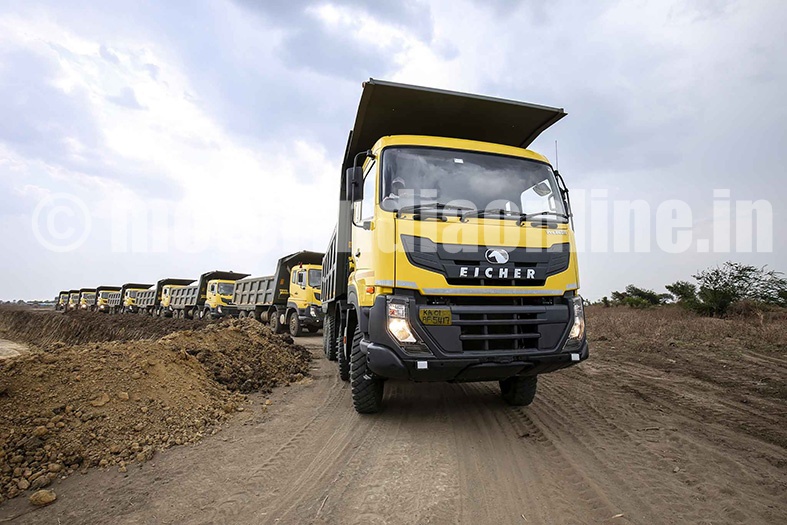The Indian commercial vehicle market grew by 12% in FY 20161 – a significant number by itself, more so because it signaled the reversal of a three-year long downturn in the market. The medium- and heavy-commercial vehicle (M&HCV) segment grew by 32%2, partially supported from the lower base figures. At a global level, while the North American and European medium- and heavy-duty truck markets grew by ~10.4% and ~11.2% in 2015, the China market experienced a significant ~23% drop3.
Trucks are one of the important workhorses in the country’s transport system characterised by six modes of transport – rail, road, coastal shipping, inland shipping, air and pipelines. India’s total freight movement was ~2000 billion tonne km in 2012, and is expected to reach ~13,000 billion tonne km by year 20324. It will not be an exaggeration to state that the transport network today is already under severe pressure and riddled with efficiency issues. A radical shift in the approach to solve the problems of the logistics sector and a concerted effort by all stakeholders to reduce inefficiencies is the need of hour.
The Enabler – Infrastructure and Policies
A fundamental shift from a silo approach to a systems approach that cuts across modes of transport, regional jurisdictions and administrative controls is needed to accelerate policy deployment across the value-chain. The total investment in transport is estimated to grow from Rs. 2.2 trillion during the 12th Five-Year Plan period to INR ~3.8 trillion by the 15th five-year plan period5. Only a collaborative approach among the rail, road, aviation, shipping and industry ministries will pave way for finding the most effective and efficient solutions at the optimal economic and social costs for the nation.
The Manufacturer – Commercial Vehicle OEMs
The very nature of trucks is changing globally – from a Product to a Solution. “Connectivity” is a single unifying theme that will transform, rather transforming, trucks as we have known them. From the basic telematics system inside the truck today to the solutions that catapult the truck as the central node of an active, connected internet of logistics, the “Connected Truck” offers immense opportunities for every stakeholder in the industry. North American and European truck manufacturers are already investing significant capital and effort in the areas of connected and autonomous trucks. In EU, automotive and telecom, otherwise unrelated industries are collaborating on pilot projects in these areas6. Indian manufacturers need to join hands and invest in such advanced technologies, which will not only enhance the efficiency of their products but also strengthen their competitive positioning in the days to come.
De-carbonisation of the automotive industry is a global theme, and the trucking industry is definitely not an exception. Every truck manufacturer underpins its product on two key parameters – Emissions and Efficiency (fuel efficiency in this case). India will complete rollout of Bharat Stage IV emissions by early 2017, and is expected to leapfrog to BS VI by 2020/ 2021. This, if happens, will be a significant step forward to bridge the gap with other developed markets such as EU (already in EU 6) and US (already in EPA 2010) . The fuel quality of 10 ppm sulphur level will also need to be achieved along with BS VI – the challenges associated thereof are beyond the scope of this article. The transport sector accounts for ~18% of total energy consumed in India, and these requirements will grow at least two-folds over the next 20 years7. A directive on fuel efficiency for heavy-duty trucks, on the lines of what exists in Europe and the US today, will preserve our energy security in the future and quite literally bring a whiff of fresh air into our daily lives.
Significant progress is also happening on fully-electric heavy-duty trucks with firms such as Daimler unveiling their e-truck last month8 and start-ups such as Nikola working on prototypes slated for release later this year9.
The Operator – Trucking companies, fleet operators, truck drivers
Road freight industry is largely an unorganized sector in India, with ~75% of trucking firms owning a fleet of less than 5 trucks. This section faces immense challenges ranging from low margins, weak market entry barriers, competitive prices, and high degree of substitutability10. With trends such as e-commerce expected to grow multi-folds over the next two decades, the trucking industry needs to adapt to newer business models, shorter delivery times and tighter margins.
In such market conditions, solutions that reduce cost and contribute to margins will generate market interest. The emergence of new-age logistics start-ups developing solutions such as tech-enabled freight matching and brokerage points towards this market opportunity. Digitization of the industry will increase in the future as we move towards a practical maximum of freight efficiency.
Conclusion
India’s trucking sector is at the cusp of a significant shift towards revolutionizing its freight industry. Trucks of the future will be safer, cleaner and connected trucking solutions. They will go farther than before, wait lesser than today and make higher margins than ever before. They will generate, access, process significantly large amount of data and will act as a digital node of what could possibly be a physical internet of freight. The driver behind the wheel will be happier – maybe he/she does not need to drive at all?
By Ananth Srinivasan, Senior Consultant – Mobility, Frost & Sullivan
Ananth Srinivasan works as a consultant with Frost & Sullivan, currently based out of Frankfurt, Germany. He is an engineer and MBA by education, with 8+ years of experience in the automotive industry.
- ICRA May 2016 report; 2. ICRA May 2016 report; 3. Frost & Sullivan report – 2016 Outlook of Global Medium- and Heavy-duty Truck Industry; 4. India Transport Report by National Transport Development Policy Committee, 2014; 5. India Transport Report by National Transport Development Policy Committee, 2014; 6. ACEA Press Release July 2016 – http://www.acea.be/press-releases/article/automotive-and-telecoms-sectors-to-launch-eu-project-for-connected-and-auto; 7. India Transport Report by National Transport Development Policy Committee, 2014; 8. https://www.mercedes-benz.com/en/mercedes-benz/next/advanced-engineering/first-fully-electric-truck/; 9. https://nikolamotor.com/one; 10. India Transport Report by National Transport Development Policy Committee, 2014

